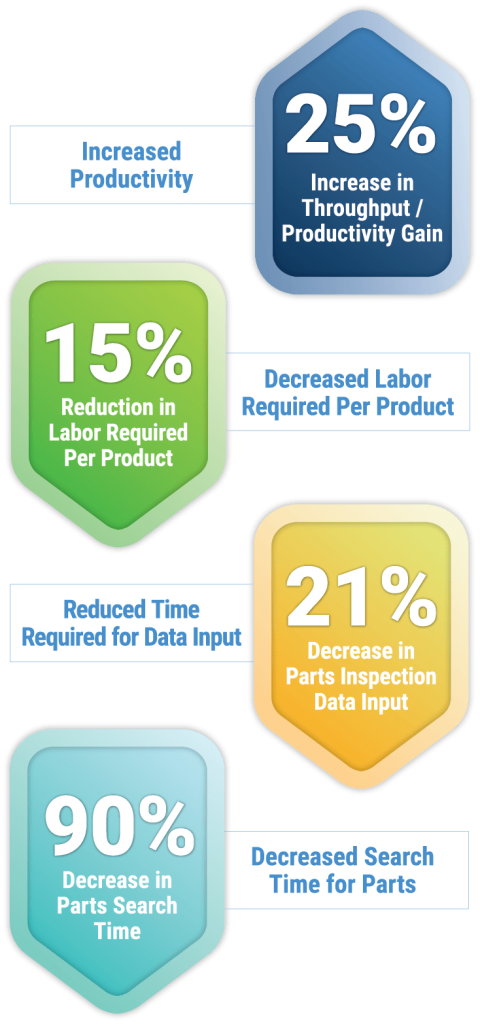
This global leader in blood processing technology looked to pump more output from its existing equipment, people and information technology, and to make its quality processes more productive. Our team established performance standards based on true capacities, enhanced workflows, and improved communication within and between departments. The results? A hearty 25% gain in productivity and $4.5 million in annual savings.

Project Overview

Performance Results
Background
Founded in 1971, our client, a Massachusetts-based company provides innovative products for the blood donation and processing industry and surgical environ-ments in 50-plus countries. Its primary operations involve manufacturing medical devices, systems, and single-use consumables to collect and process blood.
The client sought to increase its production with current resources, achieve continuous improvement and stream-line its quality systems. Company leaders also wanted to open up communication between departmental “silos” and get managers working together to solve complex problems affecting multiple areas. As a result, the client engaged us to improve operations at two of its manufac-turing facilities in the northeastern United States.
Situation Analysis
A central, underlying problem was that the company was accounting for costs and establishing standards for performance using historical financial standards rather than actual operational capabilities. They were attaining their goals – adjusted periodically – without much effort, so management saw continuous, incremental improvement instead of an organization slowing down.
Supervisors were not actively managing their people or proactively monitoring daily operations. This prevented them from quickly spotting off-schedule conditions and taking timely corrective actions. The equipment builders were given very little direction on what to build and when, which made it harder to keep production cells stocked with components.
The amount of work allocated per operator also varied widely. Two of the high-volume production lines were using too many people, which created excessive buildup of subassemblies. And, it caused needless shortages on other production lines that depended on the same parts.

Case Study: Aligning performance with capacity helps medical device maker operate at full potential
Background
Founded in 1971, our client, a Massachusetts-based company provides innovative products for the blood donation and processing industry and surgical environ-ments in 50-plus countries. Its primary operations involve manufacturing medical devices, systems, and single-use consumables to collect and process blood.
The client sought to increase its production with current resources, achieve continuous improvement and stream-line its quality systems. Company leaders also wanted to open up communication between departmental “silos” and get managers working together to solve complex problems affecting multiple areas. As a result, the client engaged us to improve operations at two of its manufac-turing facilities in the northeastern United States.
Situation Analysis
A central, underlying problem was that the company was accounting for costs and establishing standards for performance using historical financial standards rather than actual operational capabilities. They were attaining their goals – adjusted periodically – without much effort, so management saw continuous, incremental improvement instead of an organization slowing down.
Supervisors were not actively managing their people or proactively monitoring daily operations. This prevented them from quickly spotting off-schedule conditions and taking timely corrective actions. The equipment builders were given very little direction on what to build and when, which made it harder to keep production cells stocked with components.
The amount of work allocated per operator also varied widely. Two of the high-volume production lines were using too many people, which created excessive buildup of subassemblies. And it caused needless shortages on other production lines that depended on the same parts.
On another line, operators would wait to build sub- assemblies until they had the key component, slowing production.
Inspectors who reviewed incoming parts were spending an inordinate amount of time double-inputting inspection data – first manually, then into an Oracle database where it resided unused. The client also wanted to streamline its nonconforming material reporting process, which was fraught with duplicate effort and cumbersome manager signoffs.
The Results
The POWERS team identified manufacturing capacities based on the actual capability of each line or manufactur-ing cell. We focused initially on two production lines that account for 45 percent of the company’s product volume. We analyzed the activities required in each workstation, the time required to complete them, and the workload for each worker. This allowed us to determine how much truly could be produced and the line’s maximum efficiency.
Then, we rebalanced each line by incorporating the right mix of internal and external activities, and by changing each person’s activities to ensure that all operators have the same amount of work. We also determined the component inventory needed to be ready in advance, and showed workers an alternative way to work that made the line go faster. These improvements:
- Boosted output by an average of 25 percent on one high-volume line through rebalancing
- Realized a 40 percent gain in output for one cell by changing how production was paced
- Reduced the number of people required to build one product by 10 percent and eliminated overtime on its subassembly workstation
Continuous Improvement Gains
While establishing standards based on actual capabilities and capacities, we also focused on supervisory skills. We prompted managers to keep looking at issues and focus on improving every day. We instituted accountability at all levels and daily and weekly production targets.
Now, every manager and person on the line knows the goals against which performance are measured. We developed daily schedule controls for the group leaders and supervisor to manage their resources and control the standard work in process.
Today, workers get daily “pocket” cards with space to report what they have produced, which enables monitoring of individual productivity on an hourly basis. The sched-ule’s performance and equipment-tracking features also provide feedback to the production lines.
In addition, we reassigned the planning of equipment production to the corporate master planner. This allows manufacturing management to spend its time more effectively by scheduling resources and executing the equipment organization’s plan.
High-Impact Efficiency Gains
Our team worked with the IT department to streamline inspection of incoming parts. Choosing manual versus computer data entry cut the time spent on double data input by 21 percent. We also redesigned the entire discrepant parts process and sharply reduced the amount of time it required. Operators can now retrieve the information needed to complete a transaction in less than a minute. And, discrepant material is returned to suppliers faster and takes up far less space.
We organized cross-functional teams that meet daily to report on the prior day’s attainment and address specific issues, and that collaborate to solve larger, systemic challenges. Working together, managers can more easily anticipate problems and head them off.
Today, the organization is producing 15 percent more with existing resources, for an annual cost savings of $4.5 million.
Overall Performance Improvements
- Determined the true capacities and capabilities of the business
- Established performance measures based on realistic versus historic standards
- Implemented structured process to identify, monitor and resolve barriers to maximum performance
- Instituted daily schedule control with hourly production targets
- Added performance and equipment-tracking features to daily schedule control for feedback to production lines
- Streamlined processing of incoming and discrepant parts
- Freed up extensive space by clearing inventories of discrepant parts
- Organized cross-functional teams to monitor daily attainment and tackle vexing issues
- Instituted weekly workshops to develop supervisors’ leadership and management skills
- Ensured supervisors and line workers knew what was expected of them and when
- Improved supervisors’ communications skills and speeded the resolution of problems





